This blog contains affiliate links. As part of afiiliate networks and as an Amazon Associate, I earn from qualifying purchases. If you make a purchase through these links, I may earn a small commission at no additional cost to you. I only recommend products and services that I believe in and have personally used or researched. Your support helps me continue to provide quality content—thank you!
Sri Lanka offers exceptional wild elephant viewing opportunities across several ethical destinations. You’ll find the highest concentrations at Udawalawe National Park, known for reliable sightings, and Minneriya during the famous “Gathering” (July-October). For rehabilitation efforts, visit the Elephant Transit Home where orphaned calves are prepared for release. Pinnawala Elephant Orphanage houses rescued elephants in a sanctuary setting. These locations balance tourism with conservation, ensuring these magnificent creatures thrive in their natural habitats.
Introduction
When considering the majesty of Earth’s largest land mammals, few wildlife experiences rival an elephant encounter in their natural habitat. Sri Lanka offers some of the world’s best opportunities to observe these gentle giants up close, where they roam freely in protected areas across the island nation.
Understanding elephant behavior enhances your wildlife viewing experience. You’ll notice how these highly intelligent creatures form close family bonds, communicate through low-frequency rumbles, and display complex social interactions.
Their natural behaviors—from dust bathing to foraging—are fascinating to witness in the wild.
Sri Lanka’s conservation efforts have created safe havens for its estimated 5,000 wild elephants. These initiatives balance tourism with protection, ensuring these endangered animals thrive despite habitat loss and human-elephant conflict.
National Parks for Elephant Safaris
Sri Lanka’s national parks offer you unparalleled opportunities to witness Asian elephants in their natural habitat, with Udawalawe, Minneriya, Kaudulla, Wasgamuwa, and Yala each providing unique conservation settings.
You’ll encounter different elephant behaviors across these protected areas, from the famous “The Gathering” at Minneriya where hundreds congregate around the ancient reservoir during dry months, to the more intimate family group sightings at Wasgamuwa.
When visiting these sanctuaries, remember that maintaining proper distance and respecting wildlife corridors supports essential conservation efforts that protect these endangered gentle giants for future generations.
Udawalawe National Park
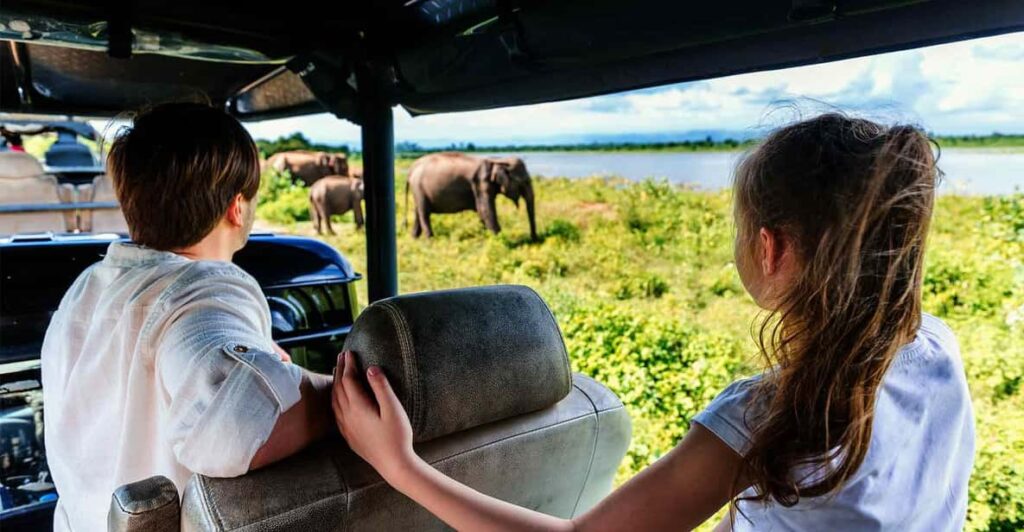
For wildlife enthusiasts on a budget, Udawalawe’s private safari packages offer extensive experiences that include both park entrance fees and a visit to the Elephant Transit Home where you’ll witness ethical conservation practices.
Your all-inclusive tour provides 3-3.5 hours of wildlife observation with an English-speaking guide who’ll help you spot elephants in their natural habitat without disturbing their behaviors.
Minneriya National Park
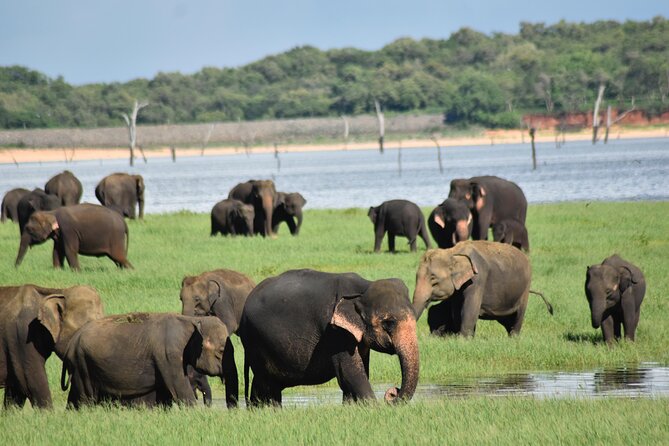
Located in Sri Lanka’s North Central Province, Minneriya National Park offers one of the most spectacular elephant gatherings in the world. During the dry season, hundreds of elephants migrate to the ancient Minneriya Tank, creating a wildlife phenomenon that’s essential to study elephant behavior in natural settings.
You’ll commence on a 3 to 3.5-hour safari with expert guides who’ll share insights about wildlife conservation efforts while helping you spot not just elephants, but also leopards, sloth bears, and deer.
The park’s commitment to responsible tourism guarantees minimal disruption to natural habitats while supporting preservation initiatives.
With flexible booking options including hotel transfers and English-speaking guides, you can witness these magnificent creatures interact, bathe, and forage against lush landscapes – an unforgettable experience that connects you directly to Sri Lanka’s precious ecosystems.
Kaudulla National Park
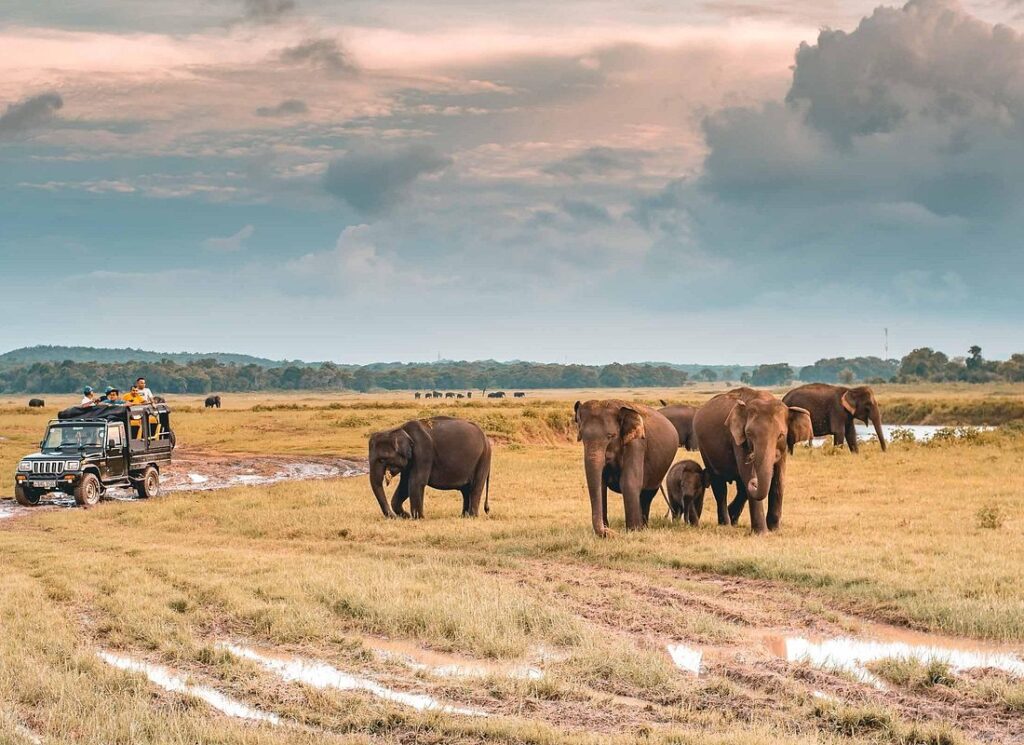
Renowned for hosting the magnificent “Elephant Gathering,” Kaudulla National Park offers wildlife enthusiasts an authentic Sri Lankan safari experience where conservation meets adventure.
During dry seasons, herds congregate around Kaudulla Tank, creating spectacular viewing opportunities.
A four-hour safari provides approximately three hours inside the park, where you’ll encounter not just elephants but also crocodiles, deer, eagles, monkeys, and water monitors.
Bird enthusiasts will appreciate the diverse avian population.
Book with local eco-tour operators who provide knowledgeable English-speaking guides, bottled water, and transportation.
Remember to wear comfortable clothes, bring a hat, and respect wildlife by maintaining appropriate distances.
Best For: Wildlife photographers and nature enthusiasts seeking an authentic elephant-watching experience in Sri Lanka with knowledgeable guides and convenient hotel transfers.
Pros:
- 3-hour safari time provides ample opportunity to witness the famous “Elephant Gathering” and diverse wildlife in their natural habitat
- Includes hotel pickup/drop-off, bottled water, and national park entrance tickets for a hassle-free experience
- Flexible booking with free 24-hour cancellation and reserve now, pay later options
Cons:
- Wildlife sightings are not guaranteed and may vary depending on the season and natural migration patterns
- Limited to 4-hour duration which may not be sufficient for travelers wanting a full-day wildlife experience
- Pickup only available from specific areas (Dambulla, Kandalama, Sigiriya, and Habarana)
Wasgamuwa National Park
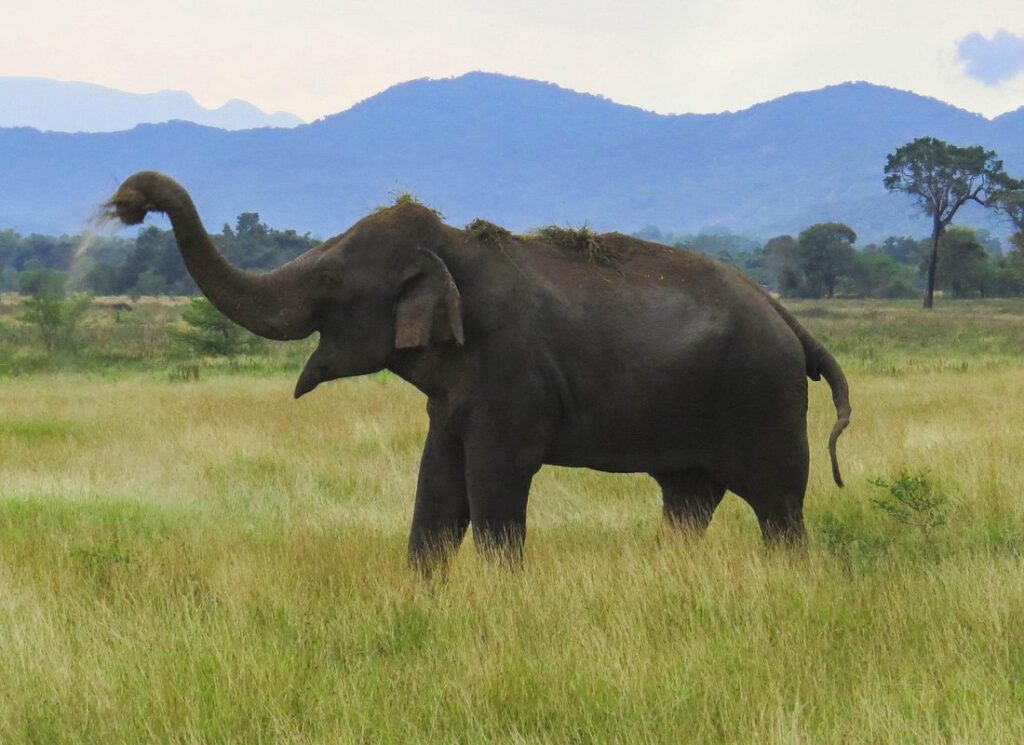
Sri Lanka’s Wasgamuwa National Park offers a pristine elephant viewing experience that’s ideal for wildlife enthusiasts who prefer authentic encounters away from crowds. Located in the island’s north-central province, this protected sanctuary hosts approximately 150 elephants within its 39,000 hectares of diverse habitat.
You’ll witness remarkable elephant behavior here, including the unique “tank elephants” that gather in reservoir areas during dry seasons. The park’s conservation efforts focus on mitigating human-elephant conflict in surrounding villages. When visiting, maintain a respectful 100-meter distance from elephants, supporting their natural behaviors and habitat preservation. The best viewing times are dawn and dusk when herds emerge from forest cover.
Yala National Park
Yala National Park stands as one of Sri Lanka’s premier destinations for elephant safaris, presenting a different yet equally compelling experience compared to Wasgamuwa. While exploring this biodiversity hotspot, you’ll have opportunities to witness elephants in their natural habitat alongside the park’s famous leopard population.
For the ultimate Yala wildlife experience, consider staying at the park’s eco-conscious safari camp, featuring spacious canvas tents with modern amenities, without compromising on sustainability. These accommodations follow strict Yala conservation guidelines, minimizing environmental impact while maximizing your connection to nature.
Guests consistently praise the knowledgeable guides who enhance wildlife sightings with scientific insights.
After thrilling day safaris, you can relax in exclusive hot tubs while reflecting on conservation efforts that protect these magnificent animals for future generations.
Ethical Elephant Sanctuaries & Orphanages
Ethical elephant sanctuaries offer you a chance to observe these magnificent creatures while supporting their rescue and rehabilitation.
Sri Lanka’s renowned facilities like Pinnawala Elephant Orphanage and Elephant Transit Home (Eth Athuru Sevana) provide critical care for orphaned and injured elephants affected by human-wildlife conflict.
The Millangoda Elephant Conservation Center and Elephant Freedom Project in Kegalle further exemplify conservation efforts where you’ll learn about sustainable practices that protect these endangered giants for future generations.
Pinnawala Elephant Orphanage
The Pinnawala Elephant Orphanage offers wildlife enthusiasts and conservation-minded travelers a rare opportunity to observe the world’s largest herd of captive elephants in a sanctuary setting.
Established in 1975 by Sri Lanka’s Department of Wildlife Conservation, this rehabilitation center currently houses 71 elephants (30 males, 41 females).
The orphanage made conservation history in 2021 when an elephant named Surangi gave birth to twins—the first occurrence in Sri Lanka since 1941.
You’ll find the sanctuary in Pinnawala village, 13km northeast of Kegalle.
Plan for the $18 entrance fee and consider visiting as part of a day tour from Kandy.
Best For: Wildlife enthusiasts and families interested in elephant conservation who want to observe a large herd of captive elephants in a sanctuary environment.
Pros:
- Home to the world’s largest captive elephant herd with 71 elephants, offering unique wildlife viewing opportunities
- Historic conservation site that made headlines in 2021 with the rare birth of elephant twins
- Easily accessible as part of a day tour from Kandy with reasonable entrance fees
Cons:
- The $18 entrance fee is not included in most tour packages and requires separate payment
- Ethical considerations regarding captive elephant facilities may concern some conservation-minded travelers
- Limited time at the orphanage when visited as part of the comprehensive day tour from Kandy
Elephant Transit Home (Eth Athuru Sevana)
Located adjacent to Udawalawe National Park, the Elephant Transit Home (Eth Athuru Sevana) offers wildlife enthusiasts a chance to witness elephant conservation in action while maintaining ethical distance from these magnificent creatures.
Unlike other attractions, this rehabilitation center focuses on caring for orphaned elephant calves with the goal of releasing them back into the wild.
You’ll observe feeding sessions from a viewing platform—no riding or direct contact permitted. This facility is included in the Udawalawe Safari Tour package, making it easy to incorporate into your wildlife experience.
The center represents Sri Lanka’s commitment to ethical wildlife conservation, prioritizing animal welfare over tourist entertainment.
Best For: Wildlife enthusiasts and nature photographers who want to observe elephants and other wildlife in their natural habitat while supporting ethical conservation efforts.
Pros:
- Experienced guides with 10 years of expertise who know the best wildlife viewing locations, enhancing chances of memorable sightings
- Comprehensive package including private 4×4 jeep, water, park fees, and access to the Elephant Transit Home rehabilitation center
- Flexible booking with 24-hour cancellation policy and no immediate payment required
Cons:
- Not accessible for visitors with mobility impairments
- Food options limited with only snacks and water provided (no breakfast or lunch)
- Additional charges apply for pick-up services from hotels outside the Udawalwe area
Millangoda Elephant Conservation Center (Kegalle)
Nestled in the verdant hills of Kegalle district, Millangoda Elephant Conservation Center stands as a pioneer in Sri Lanka’s ethical elephant protection movement.
Unlike commercial elephant attractions, the center focuses on natural elephant behavior, allowing you to observe these magnificent creatures in a less contrived setting.
You’ll witness elephants engaging in their natural social dynamics, from matriarchal leadership to playful interactions among calves.
The center’s conservation efforts include habitat preservation, anti-poaching initiatives, and community education programs.
What makes Millangoda special is their commitment to scientific research on elephant behavior and welfare.
Their work has contributed remarkably to elephant conservation across Sri Lanka.
When you visit, knowledgeable guides explain the challenges facing wild elephant populations and how sustainable tourism supports their protection.
Elephant Freedom Project (Kegalle)
Among the most progressive elephant sanctuaries in Sri Lanka, the Elephant Freedom Project in Kegalle stands as a true refuge for captive elephants seeking escape from exploitation.
This intimate sanctuary focuses on elephant rehabilitation and humane treatment, currently providing a peaceful haven for two residents: Kumari and Menike.
You’ll find no riding or circus tricks here—only respectful walks alongside these magnificent creatures.
Located conveniently between Colombo and Kandy, the project maintains small visitor numbers to guarantee a stress-free environment.
The sanctuary openly acknowledges existing challenges in elephant care, including nighttime chains while they develop proper enclosures.
Onsite accommodation is available for 16 EURO per night (plus service charge), including meals.
Advanced booking is essential for all activities, reflecting their commitment to responsible tourism and elephant welfare.
Other Unique Places to See Elephants
If you’re seeking less-visited elephant habitats in Sri Lanka, consider the serene landscapes of Habarana, Gal Oya, and Maduru Oya National Parks where conservation efforts protect these endangered giants in their natural settings.
The ancient reservoir area of Kala Wewa near the Avukana Buddha statue offers a unique opportunity to witness elephants against a backdrop of historical significance.
These protected regions provide critical habitat corridors that allow elephants to maintain their natural migratory patterns while minimizing human-wildlife conflict.
Habarana
Wildlife enthusiasts seeking authentic elephant encounters will find Habarana an exceptional destination in Sri Lanka. This region serves as the gateway to Hurulu Eco Park, a UNESCO biosphere reserve where you’ll experience remarkable wildlife viewing opportunities.
The park offers 3-3.5 hour safaris during ideal wildlife activity periods—sunrise and sunset. Morning tours showcase elephants in their active feeding phases, while evening excursions might reward you with sightings of elephants alongside nocturnal species.
Expert naturalist guides enhance your experience with conservation insights, ensuring respectful wildlife observation. The flexible booking policy allows cancellation up to 24 hours in advance, making this an accessible option for responsible elephant watching.
Best For: Wildlife enthusiasts and nature photographers seeking authentic elephant encounters in their natural habitat while supporting conservation efforts.
Pros:
- Flexible booking with free cancellation up to 24 hours in advance and no upfront payment required
- Expert naturalist guides provide educational insights on wildlife conservation and behavior
- Morning and evening safari options optimize wildlife viewing opportunities, especially for elephants
Cons:
- Wildlife sightings, particularly leopards and sloth bears, are not guaranteed
- 3-3.5 hour duration may be insufficient for travelers seeking extended immersion in the ecosystem
- Limited amenities during the safari experience for those expecting luxury accommodations
Gal Oya National Park
Unlike traditional jeep safaris, Gal Oya’s boat safaris provide a non-intrusive way to witness elephants in their natural habitat.
You’ll marvel as these surprisingly buoyant mammals use their trunks as snorkels while crossing the waters of Senanayake Samudraya.
The park’s wildlife interactions are carefully managed to minimize human impact.
Visit during dry season (June to September) when elephants frequently swim between islands in search of food.
The Veddha indigenous community, who serve as guides, share generations of knowledge about ethical elephant observation.
Remember to maintain distance and respect these endangered creatures’ space during your unforgettable Gal Oya experience.
Maduru Oya National Park
Located in Sri Lanka’s North Central Province, Maduru Oya National Park offers five massive reservoirs where over 150 elephants gather during dry seasons.
These water sources provide perfect wildlife photography opportunities as herds display natural elephant behavior like bathing, drinking, and social interactions at dawn and dusk.
The park’s protected status helps maintain vital elephant corridors between eastern and central regions.
When you visit, respect viewing guidelines that prioritize elephant welfare over perfect photos. Responsible eco-tourism here directly funds conservation efforts and supports local communities.
Maduru Oya’s relatively low visitor numbers means you’ll enjoy more authentic elephant encounters than at busier parks.
Consider visiting with certified guides who understand elephant behavior and can identify signs of stress, ensuring your presence doesn’t disrupt these magnificent creatures in their natural habitat.
Kala Wewa & Avukana Buddha Statue Area
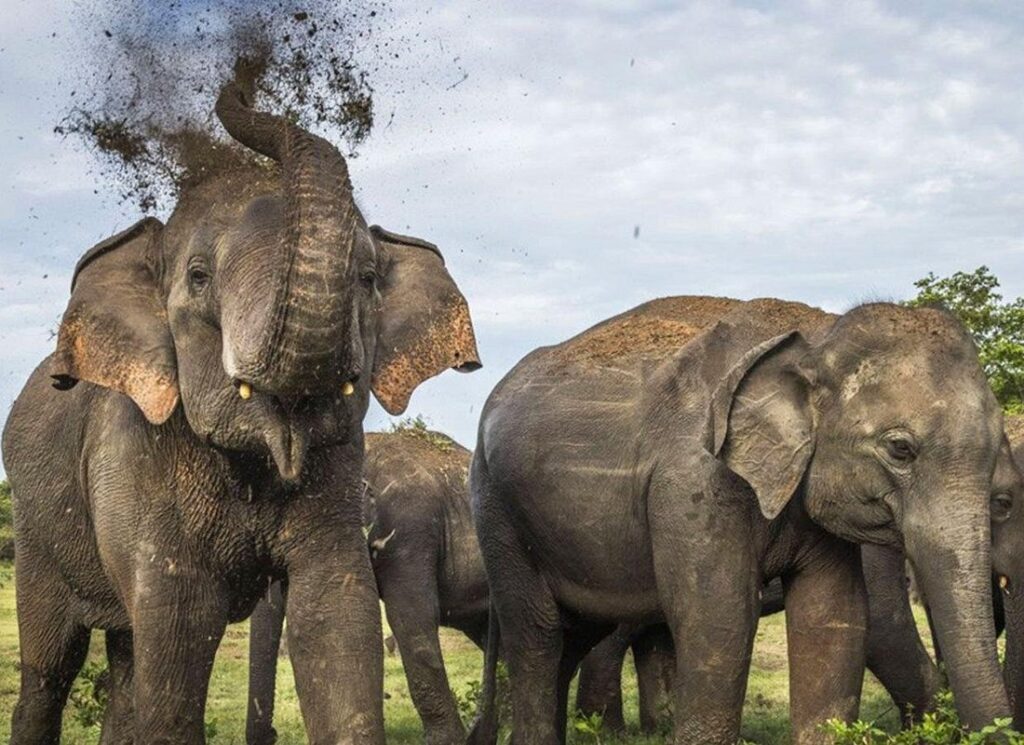
Beyond the typical safari destinations, the ancient reservoir of Kala Wewa and surrounding Avukana Buddha statue area offer a remarkable opportunity to witness elephants in a setting where history and nature converge.
You’ll often spot pachyderms wandering near this 5th century irrigation tank while you’re visiting the imposing 42-foot Avukana Buddha statue. The elephants typically emerge at dusk, crossing the water and grazing along the shorelines.
This coexistence highlights the sustainable relationship between ancient infrastructure and wildlife conservation that has persisted for centuries.
When visiting, maintain at least 100 meters distance from these endangered creatures. Remember, this isn’t a designated sanctuary but a natural habitat where elephants thrive alongside human heritage sites.
Supporting local conservation initiatives helps guarantee these elephants can safely migrate through their traditional corridors near Kala Wewa for generations to come.
Frequently Asked Questions
What Is the Best Time of Year to See Elephants?
You’ll spot elephants year-round, but during dry season (June-September), they’re most visible when migrating to water sources. Rainy season effects can disperse herds, altering elephant migration patterns for survival.
How Much Do Elephant Safaris and Sanctuary Visits Cost?
You’ll find elephant safari prices range from $30-100, while sanctuary visit fees typically cost $20-50. Choose operators that prioritize ethical treatment and conservation efforts rather than focusing solely on price.
Can Children Participate in Elephant Viewing Experiences?
Yes, you’ll find many family activities where children can observe elephants safely. Responsible operators offer elephant education programs teaching conservation values while promoting protection of these magnificent creatures in their natural habitat.
Are There Photography Restrictions When Viewing Elephants?
You’ll find photography etiquette enforced for elephant viewing. Don’t use flash, maintain distance, and respect wildlife regulations. Your responsible behavior helps protect these sensitive creatures from stress and habitat disruption.
How Close Can Visitors Safely Get to Wild Elephants?
You shouldn’t approach wild elephants closer than 50 meters. Safety guidelines recommend maintaining this encounter distance to protect both you and these sensitive creatures from potentially dangerous interactions.
Conclusion
Sri Lanka’s elephants are national treasures that need your protection. As you’ve discovered, you can observe these magnificent creatures ethically in national parks and legitimate sanctuaries. Remember, your tourism choices directly impact their welfare. By supporting conservation-focused experiences and avoiding exploitative attractions, you’re helping guarantee these endangered giants survive for generations. Your responsible travel decisions make all the difference in protecting Sri Lanka’s wild elephant populations.

Erzsebet Frey (Eli Frey) is an ecologist and online entrepreneur with a Master of Science in Ecology from the University of Belgrade. Originally from Serbia, she has lived in Sri Lanka since 2017. Eli has worked internationally in countries like Oman, Brazil, Germany, and Sri Lanka. In 2018, she expanded into SEO and blogging, completing courses from UC Davis and Edinburgh. Eli has founded multiple websites focused on biology, ecology, environmental science, sustainable and simple living, and outdoor activities. She enjoys creating nature and simple living videos on YouTube and participates in speleology, diving, and hiking.
🌿 Explore the Wild Side!
Discover eBooks, guides, templates and stylish wildlife-themed T-shirts, notebooks, scrunchies, bandanas, and tote bags. Perfect for nature lovers and wildlife enthusiasts!
Visit My Shop →
